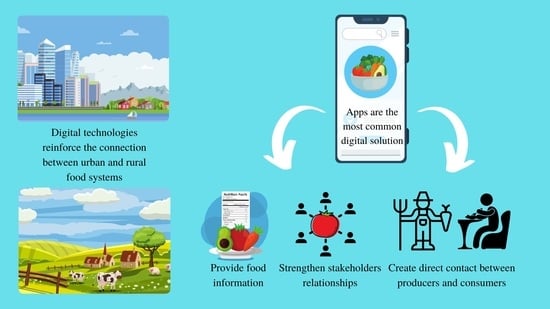Innovative Digital Technologies for Purchasing and Consumption in Urban and Regional Agro-Food Systems: A Systematic Review
Abstract
1. Introduction
- How digital technologies reinforce the connection between urban and regional food systems.
- 2.
- How digital technologies change food shopping experiences for consumers and food selling for producers and retailers.
- 3.
- The characteristics of mobile phone Apps, and to highlight App differences compared to other digital technologies.
2. Materials and Methods
2.1. Data Collection
2.2. Data Analysis
- ―
- Research studies characteristics:
- ―
- temporal and geographical distribution;
- ―
- fields of research;
- ―
- aim of the study;
- ―
- focus on urban and rural areas.
- ―
- Digital technologies characteristics:
- ―
- types of digital technologies;
- ―
- aims of digital technologies;
- ―
- section of the agro-food chain where digital technologies operate;
- ―
- key features of digital technologies.
3. Results
3.1. Temporal and Geographical Distribution of the Research Studies
3.2. Research Studies′ Fields and Aims
- ―
- the implications of digital technologies on local and sustainable consumption (35% of research studies);
- ―
- the effects of digital technologies on healthy eating (26% of research studies);
- ―
- the effects of digital technologies on farm marketing (19% of research studies).
| Aims of the Studies | n of Studies | References | |
|---|---|---|---|
| 1 | Study the implications of digital technologies on local and sustainable consumption | 20 (35%) | [29,31,32,34,35,36,38,40,41,42,45,47,52,53,56,59,62,67,77,78,79] |
| 2 | Study the effects of digital technologies on healthy eating | 15 (26%) | [30,37,38,43,55,58,61,72,74,76,80,81,83,84,85] |
| 3 | Study the effects of digital technologies on farm marketing | 11 (19%) | [29,33,35,39,41,46,56,60,71,78,79] |
| 4 | Study the role of digital technologies in farm management | 7 (12%) | [29,50,51,68,69,70,75] |
| 5 | Study the effects of digital technologies on the HORECA sector | 5 (9%) | [55,63,64,66,73] |
| 6 | Present an App prototype | 4 (7%) | [49,53,57,83] |
| 7 | Study the effects of digital technologies on tourism | 3 (5%) | [42,44,48] |
| 8 | Study the role of digital in the retail sector | 2 (4%) | [65,82] |
3.3. Focus on Urban or Rural Areas
3.4. Types of Digital Technologies Studied in the Research
3.5. Aims of Digital Technologies
3.6. Section of the Agro-Food Chain where Digital Technologies Operate
3.7. Digital Technologies’ Key Features
4. Conclusions
Author Contributions
Funding
Institutional Review Board Statement
Informed Consent Statement
Data Availability Statement
Conflicts of Interest
References
- Food and Agriculture Organisation. Realising the Potential of Digitalisation to Improve the Agri-food System; FAO: Rome, Italy, 2020. [Google Scholar]
- Prause, L.; Hackfort, S.; Lindgren, M. Digitalization and the Third Food Regime. Available online: https://link.springer.com/article/10.1007/s10460-020-10161-2 (accessed on 20 September 2020).
- Food and Agriculture Organisation. Regional Conference for Asia and the Pacific; FAO: Rome, Italy, 2020. [Google Scholar]
- United Nations System Standing Committee on Nutrition. Nutrition in a Digital World; UNSCN: Rome, Italy, 2020. [Google Scholar]
- European Commission. A Smart and Sustainable Digital Future for European Agriculture and Rural Areas. 2019. Available online: https://ec.europa.eu/digital-single-market/en/news/eu-member-states-join-forces-digitalisation-european-agriculture-and-rural-areas (accessed on 20 September 2020).
- European Commission. The European Green Deal. 2019. Available online: https://eur-lex.europa.eu/legal-content/EN/TXT/?qid=1588580774040&uri=CELEX:52019DC0640 (accessed on 20 September 2020).
- United Nations. New Urban Agenda. Draft Resolution Submitted by the President of the General Assembly. 2016. Available online: http://habitat3.org/wp-content/uploads/N1639668-English.pdf (accessed on 24 May 2020).
- Blay-Palmer, A.; Santini, G.; Dubbeling, M.; Renting, H.; Taguchi, M.; Giordano, T. Validating the city region food system approach: Enacting inclusive, transformational city region food systems. Sustainability 2018, 10, 1680. [Google Scholar] [CrossRef]
- van der Gaast, K.; van Leeuwen, E.; Wertheim-Heck, S. City-Region Food Systems and Second Tier Cities: From Garden Cities to Garden Regions. Sustainability 2020, 12, 2532. [Google Scholar] [CrossRef]
- Hawkes, C.; Halliday, J. What Makes Urban Food Policies Happen? Insights from Five Case Studies; IPES-Food: Brussels, Belgium, 2017. [Google Scholar]
- Eurostat. Internet Purchases by Individuals (Until 2019). 2019. Available online: https://ec.europa.eu/eurostat/databrowser/view/ISOC_EC_IBUY__custom_115411/default/line?lang=en (accessed on 20 September 2020).
- Oncini, F.; Bozzini, E.; Forno, F.; Magnani, N. Towards food platforms? An analysis of online food provisioning services in Italy. Geoforum 2020, 114, 172–180. [Google Scholar] [CrossRef]
- Nielsen. Predicting the Online Shopper Shifts Driving E-commerce Momentum. 2020. Available online: https://www.nielsen.com/us/en/insights/article/2020/predicting-the-online-shopper-shifts-driving-e-commerce-momentum/ (accessed on 15 December 2020).
- Elms, J.; De Kervenoael, R.; Hallsworth, A. Internet or Store? An Ethnographic Study of Consumers’ Internet and Store-based Grocery Shopping Practices. J. Retail. Consum. Serv. 2016, 32, 234–243. [Google Scholar] [CrossRef]
- Statista. Number of Smartphone Users Worldwide from 2016 to 2021 (in Billions). 2020. Available online: https://www.statista.com/statistics/330695/number-of-smartphone-users-worldwide/ (accessed on 20 November 2020).
- Statista. Number of Mobile App Downloads Worldwide from 2016 to 2019 (in Billions). 2020. Available online: https://www.statista.com/statistics/271644/worldwide-free-and-paid-mobile-app-store- downloads/ (accessed on 20 November 2020).
- Statista. Most Popular Apple App Store Categories in August 2020, by Share of Available Apps. 2020. Available online: https://www.statista.com/statistics/270291/popular-categories-in-the-app- store/ (accessed on 20 November 2020).
- Rabbi, M.; Pfammatter, A.; Zhang, M.; Spring, B.; Choudhury, T. Automated personalized feedback for physical activity and dietary behavior change with mobile phones: A randomized controlled trial on adults. JMIR Mhealth Uhealth 2015, 3, e42. [Google Scholar] [CrossRef]
- Coughlin, S.S.; Whitehead, M.; Sheats, J.Q.; Mastromonico, J.; Hardy, D.; Smith, S. Smartphone applications for promoting healthy diet and nutrition: A literature review. Jacobs J. Food Nutr. 2015, 2, 021. [Google Scholar]
- Elbert, S.P.; Dijkstra, A.; Oenema, A. A mobile phone app intervention targeting fruit and vegetable consumption: The efficacy of textual and auditory tailored health information tested in a randomized controlled trial. J. Med. Internet Res. 2016, 18, e147. [Google Scholar] [CrossRef]
- Schoeppe, S.; Alley, S.; Van Lippevelde, W.; Bray, N.A.; Williams, S.L.; Duncan, M.J.; Vandelanotte, C. Efficacy of interventions that use apps to improve diet, physical activity and sedentary behaviour: A systematic review. Int. J. Behav. Nutr. Phys. Act. 2016, 13, 127. [Google Scholar] [CrossRef]
- Mummah, S.A.; Mathur, M.; King, A.C.; Gardner, C.D.; Sutton, S. Mobile technology for vegetable consumption: A randomized controlled pilot study in overweight adults. JMIR Mhealth Uhealth 2016, 4, e51. [Google Scholar] [CrossRef]
- Covolo, L.; Ceretti, E.; Moneda, M.; Castaldi, S.; Gelatti, U. Does evidence support the use of mobile phone apps as a driver for promoting healthy lifestyles from a public health perspective? A systematic review of Randomized Control Trials. Patient Educ. Couns. 2017, 100, 2231–2243. [Google Scholar] [CrossRef]
- Samoggia, A.; Riedel, B. Assessment of nutrition-focused mobile apps’ influence on consumers’ healthy food behaviour and nutrition knowledge. Food Res. Int. 2020, 128, 108766. [Google Scholar] [CrossRef] [PubMed]
- Doub, A.E.; Levin, A.; Heath, C.E.; LeVangie, K. Mobile app-etite: Consumer attitudes towards and use of mobile technology in the context of eating behaviour. J. Directdata Digit. Mark. Pract. 2015, 17, 114–129. [Google Scholar] [CrossRef]
- Moher, D.; Liberati, A.; Tetzlaff, J.; Altman, D.G. Preferred Reporting Items for Systematic Reviews and Meta-Analyses: The PRISMA Statement. BMJ 2009, 339, 332–336. [Google Scholar] [CrossRef] [PubMed]
- Luo, H.; Lei, J. Emerging Technologies for Interactive Learning in the ICT Age. In Educational Stages and Interactive Learning: From Kindergarten to Workplace Training, 1st ed.; IGI Global: Hershey, PA, USA, 2012; pp. 73–91. [Google Scholar]
- FAO: Information and Communication Technologies (ICT). Available online: http://aims.fao.org/information-and-communication-technologies-ict (accessed on 20 November 2020).
- Davies, F.T.; Garrett, B. Technology for Sustainable Urban Food Ecosystems in the Developing World: Strengthening the Nexus of Food–Water–Energy–Nutrition. Front. Sustain. Food Syst. 2018, 2, 84. [Google Scholar] [CrossRef]
- Rossi, M.C.; Perozzi, C.; Consorti, C.; Almonti, T.; Foglini, P.; Giostra, N.; Nanni, P.; Talevi, S.; Bartolomei, D.; Vespasiani, G. An interactive diary for diet management (DAI): A new telemedicine system able to promote body weight reduction, nutritional education, and consumption of fresh local produce. Diabetes Technol. Ther. 2010, 12, 641–647. [Google Scholar] [CrossRef]
- Davies, A.R. Co-creating sustainable eating futures: Technology, ICT and citizen–consumer ambivalence. Futures 2014, 62, 181–193. [Google Scholar] [CrossRef]
- Vallauri, U. Transition Belsize Veg Bag scheme: The role of ICTs in enabling new voices and community alliances around local food production and consumption. Futures 2014, 62, 173–180. [Google Scholar] [CrossRef]
- Arapovic, A.O.; Karkin, Z. The Impact of Agricultural Market Information System in Bosnia & Herzegovina on Market Integration: Assymetric Information and Market Performance. Khazar J. Humanit. Soc. Sci. 2015, 18, 56–66. [Google Scholar]
- Bacarella, S.; Altamore, L.; Valdesi, V.; Chironi, S.; Ingrassia, M. Importance of food labeling as a means of information and traceability according to consumers. Adv. Hortic. Sci. 2015, 29, 145–151. [Google Scholar]
- Joosse, S.; Hracs, B.J. Curating the quest for ‘good food’: The practices, spatial dynamics and influence of food-related curation in Sweden. Geoforum 2015, 64, 205–216. [Google Scholar] [CrossRef]
- Eli, K.; Dolan, C.; Schneider, T.; Ulijaszek, S. Mobile activism, material imaginings, and the ethics of the edible: Framing political engagement through the Buycott app. Geoforum 2016, 74, 63–73. [Google Scholar] [CrossRef]
- Gupta, R. Food security and safety using advanced information and communication technologies (ICTs). In Proceedings of the Second International Conference on Information and Communication Technology for Competitive Strategies, Udaipur, India, 4–5 March 2016; Association for Computing Machinery: New York, NY, USA, 2016. [Google Scholar]
- Pieniak, Z.; Żakowska-Biemans, S.; Kostyra, E.; Raats, M. Sustainable healthy eating behaviour of young adults: Towards a novel methodological approach. BMC Public Health 2016, 16, 577. [Google Scholar] [CrossRef] [PubMed]
- Tadei, R.; Fadda, E.; Gobbato, L.; Perboli, G.; Rosano, M. An ICT-based reference model for e-grocery in smart cities. In Proceedings of the International Conference on Smart Cities, Malaga, Spain, 15–17 June 2016; Springer: Cham, Switzerland, 2016. [Google Scholar]
- Della Gala, M.; Reed, M. The role of ICTs in supporting collaborative networks in the agro-food sector: Two case studies from south west England. In Working Conference on Virtual Enterprises; Springer: Cham, Switzerland, 2017; pp. 707–714. [Google Scholar]
- Quaranta, G.; Salvia, R. Participatory approach to a place-based sustainable rural development: E-market platform for a resilient agri-food chain. J. Environ. Prot. Ecol. 2017, 18, 616–622. [Google Scholar]
- Duignan, M.; Everett, S.; Walsh, L.; Cade, N. Leveraging physical and digital liminoidal spaces: The case of the# EATCambridge festival. Tour. Geogr. 2018, 20, 858–879. [Google Scholar]
- Marchetti, D.; Fraticelli, F.; Polcini, F.; Fulcheri, M.; Mohn, A.A.; Vitacolonna, E. A school educational intervention based on a serious game to promote a healthy lifestyle. Mediterr. J. Clin. Psychol. 2018, 6, 1–16. [Google Scholar]
- Bassano, C.; Barile, S.; Piciocchi, P.; Spohrer, J.C.; Iandolo, F.; Fisk, R. Storytelling about places: Tourism marketing in the digital age. Cities 2019, 87, 10–20. [Google Scholar] [CrossRef]
- De Bernardi, P.; Bertello, A.; Venuti, F. Online and on-site interactions within alternative food networks: Sustainability impact of knowledge-sharing practices. Sustainability 2019, 11, 1457. [Google Scholar] [CrossRef]
- Ievoli, C.; Belliggiano, A.; Marandola, D.; Milone, P.; Ventura, F. Information and communication infrastructures and new business models in rural areas: The case of Molise region in Italy. Eur. Countrys. 2019, 11, 475–496. [Google Scholar] [CrossRef]
- De Bernardi, P.; Bertello, A.; Venuti, F. Community-Oriented motivations and knowledge sharing as drivers of success within food assemblies. In Exploring Digital Ecosystems; Springer: Cham, Switzerland, 2020; pp. 443–457. [Google Scholar]
- Lee, J.; Kaipainen, K.; Väänänen, K. Local foodie: Experience design of a mobile augmented reality application for tourists to encourage local food consumption. In Proceedings of the 23rd International Conference on Academic Mindtrek, Tampere, Finland, 29–30 January 2020; Association for Computing Machinery: New York, NY, USA, 2020. [Google Scholar]
- Poelman, M.P.; van Lenthe, F.J.; Scheider, S.; Kamphuis, C.B. A Smartphone App Combining Global Positioning System Data and Ecological Momentary Assessment to Track Individual Food Environment Exposure, Food Purchases, and Food Consumption: Protocol for the Observational FoodTrack Study. JMIR Res. Protoc. 2020, 9, e15283. [Google Scholar] [CrossRef]
- Moon, J.; Hossain, M.D.; Kang, H.G.; Shin, J. An analysis of agricultural informatization in Korea: The government’s role in bridging the digital gap. Inf. Dev. 2012, 28, 102–116. [Google Scholar] [CrossRef]
- Ahmed, M.; Ozaki, A.; Ogata, K.; Ito, S.; Miyajima, I.; Ahmed, A.; Okayasu, T.; Choudhury, D.K.; Al Amin, N. Poor farmer, entrepreneurs and ICT relation in production & marketing of quality vegetables in Bangladesh. J. Fac. Agric. Kyushu Univ. 2016, 61, 241–250. [Google Scholar]
- Srividya, N. Retail online kirana stores. Indian J. Sci. Technol. 2016, 9, 1–7. [Google Scholar] [CrossRef][Green Version]
- Yen, L.P.; Zaaba, Z.F. Malaycious: Usable mobile food finding application. In Proceedings of the Knowledge Management International Conference (KMICe), Chiang Mai, Thailand, 29–30 August 2016. [Google Scholar]
- Fauzi, A.H.; Tang, C.L.; Iskandar, D.A.; Junaini, S.N. Review and experience on developing sarawak traditional food locator mobile apps. In Proceedings of the 2017 7th IEEE International Conference on Control System, Computing and Engineering (ICCSCE), Penang, Malaysia, 24–26 November 2017; IEEE: New York, NY, USA, 2017. [Google Scholar]
- Shanita, S.N.; Rahman, A.H.A.; Azimah, A.; Izham, M.M.; Othman, N.E.; Chan, Y.T.; Pushpa, B.S.; Poh, B.K.; Ruzita, A.T. DietScore™: Sports Nutrition-based Mobile Application for Athletes and Active Individuals. In Proceedings of the 3rd International Conference on Movement, Health and Exercise, Malacca, Malaysia, 28–30 September 2016; Springer: Cham, Switzerland, 2016. [Google Scholar]
- Wicha, S.; Photiphun, T.; Janjaroenpan, P.; Taweesak, C.; Chainilwan, I.; Rodmanee, P. Proposed of e-Community Supported Agriculture (e-CSA) system to promote local organic products: The empirical study of Chiang Rai province. In Proceedings of the 2017 International Conference on Digital Arts, Media and Technology (ICDAMT), Chiang Mai, Thailand, 1–4 March 2017; IEEE: New York, NY, USA, 2017. [Google Scholar]
- Gupta, P.J.; Mhatre, H.R.; Chaudhari, A.P.; Pathari, R. Smart Livestock Trading. In Proceedings of the 2018 International Conference on Smart City and Emerging Technology (ICSCET), Mumbai, India, 5 January 2018; IEEE: New York, NY, USA, 2018. [Google Scholar]
- Kaur, J.; Kaur, M.; Webster, J.; Kumar, R. Protocol for a cluster randomised controlled trial on information technology-enabled nutrition intervention among urban adults in Chandigarh (India): SMART eating trial. Glob. Health Action 2018, 11, 1419738. [Google Scholar] [CrossRef] [PubMed]
- Anib, A.; Gayathri, A.; Shabu, K. Consumer Perception towards Swiggy Digital Food Application Service: A Analytical Study with Special Reference to Ernakulam City. Int. J. Innov. Technol. Explor. Eng. (Ijitee) 2019, 8, 1–7. [Google Scholar]
- Hossain, M.; Ahmmed, A.N.; Rahman, S.; Chan, C. Online Group Buying (OGB) in Agricultural Food Businesses: An Exploratory Study. In Proceedings of the International Working Conference on Transfer and Diffusion of IT, Portsmouth, UK, 25 June 2018; Springer: Cham, Switzerland, 2018. [Google Scholar]
- Murthy, N.; Chandrasekharan, S.; Prakash, M.P.; Kaonga, N.N.; Peter, J.; Ganju, A.; Mechael, P.N. The Impact of an mHealth Voice Message Service (mMitra) on Infant Care Knowledge, and Practices Among Low-Income Women in India: Findings from a Pseudo-Randomized Controlled Trial. Matern. Child Health J. 2019, 23, 1658–1669. [Google Scholar] [CrossRef] [PubMed]
- Nikmawati, E.E.; Widiaty, I.; Achdiani, Y.; Hurriyati, R.; Mubaroq, S.R. Educational digital media for traditional food of Kampung adat cireundeu: An ethnopedagogy perspective. J. Eng. Sci. Technol. 2019, 14, 2540–2551. [Google Scholar]
- Oborin, M.S. Digitalization of business processes in the field of food services as a factor in improving the food security of the region. In Proceedings of the 1st International Scientific Conference “Modern Management Trends and the Digital Economy: From Regional Development to Global Economic Growth” (MTDE 2019), Yekaterinburg, Russia, 14–15 April 2019; Atlantis Press: Paris, France, 2019. [Google Scholar]
- Pyanikova, E.A.; Kovaleva, A.E.; Bykovskaya, E.I. Digital technologies in public catering Industry (regional aspect). In Proceedings of the 1st International Scientific Conference” Modern Management Trends and the Digital Economy: From Regional Development to Global Economic Growth” (MTDE 2019), Yekaterinburg, Russia, 14–15 April 2019; Atlantis Press: Paris, France, 2019. [Google Scholar]
- Syaglova, Y. Digital transformation in food retailing. In IOP Conference Series: Earth and Environmental Science; IOP Publishing: Bristol, UK, 2019; Volume 274, p. 012099. [Google Scholar]
- Thamaraiselvan, N.; Jayadevan, G.R.; Chandrasekar, K.S. Digital food delivery apps revolutionizing food products marketing in India. Ease Use Secur. Cust. Trust Qual. Serv. Cust. Exp. 2019, 10, 662–665. [Google Scholar]
- Wang, H.H.; Hao, N.; Zhou, Q.; Wetzstein, M.E.; Wang, Y. Is fresh food shopping sticky to retail channels and online platforms? Evidence and implications in the digital era. Agribusiness 2019, 35, 6–19. [Google Scholar] [CrossRef]
- Chang, W.; Tuan, C.L.; Traore, S. Nonparametric procedures in ICTs-based agricultural market information network pattern analysis in western African regions. Wseas Trans. Inf. Sci. Appl. 2010, 7, 81–91. [Google Scholar]
- Henriques, J.J.; Kock, B.E. Empowering smallholders and local food markets with smartphones and social networks. In Proceedings of the 2012 IEEE Global Humanitarian Technology Conference, Seattle, WA, USA, 21–24 October 2012; IEEE: New York, NY, USA, 2012. [Google Scholar]
- Odiaka, E.C. Variations and effect of the use of mobile phones for improving farm knowledge in horticultural crops amongst farmers in Benue State, Nigeria. In Proceedings of the XXVIII International Horticultural Congress on Science and Horticulture for People (IHC2010): VI International Symposium on Horticultural Education, Research Training and Consultancy, Lisbon, Portugal, 22–27 August 2010. [Google Scholar]
- Byomire, G.; Namisango, F.; Kafuko, M.M. Use of social media to strengthen service delivery for urban agriculture in Uganda. In Proceedings of the 2016 IST-Africa Week Conference, IST-Africa 2016 Conference Proceedings, Durban, South Africa, 11–13 May 2016; Paul Cunningham and Miriam Cunningham, Ed.; IEEE: New York, NY, USA, 2016. [Google Scholar]
- Isler, J.; Sawadogo, N.H.; Harling, G.; Baernighausen, T.; Adam, M.; Kagone, M.; Sie, A.; Greuel, M.; McMahon, S.A. Iterative Adaptation of a Mobile Health Intervention Across Countries Using Human-Centered Design: Qualitative Study. JMIR Mhealth Uhealth 2019, 7, 1–18. [Google Scholar] [CrossRef]
- Koufie, M.G.E.; Kesa, H. Millennials motivation for sharing restaurant dining experiences on social media. Afr. J. Hosp. Tour. Leis. 2020, 9, 1–25. [Google Scholar]
- Mwalupaso, G.E.; Wang, S.; Eshetie, A.M.; Tian, X. Ameliorating Food and Nutrition Security in Farm Households: Does Informatization Matter? Sustainability 2020, 12, 522. [Google Scholar] [CrossRef]
- Zina, L.; Sun, Y. Corn Growth Prediction for the Upcoming Season in Burkina Faso. In Proceedings of the 2019 the 9th International Workshop on Computer Science and Engineering, Hong Kong, China, 15–17 June 2019. [Google Scholar]
- Ball, K.; Mouchacca, J.; Jackson, M. The feasibility and appeal of mobile ‘apps’ for supporting healthy food purchasing and consumption among socioeconomically disadvantaged women: A pilot study. Health Promot. J. Aust. 2014, 25, 79–82. [Google Scholar] [CrossRef] [PubMed]
- Hearn, G.; Collie, N.; Lyle, P.; Choi, J.H.J.; Foth, M. Using communicative ecology theory to scope the emerging role of social media in the evolution of urban food systems. Futures 2014, 62, 202–212. [Google Scholar] [CrossRef]
- Kurnia, S.; Hill, S.; Rahim, M.M.; Larsen, K.; Braun, P. Food hubs in Australia: Benefits, challenges and potential ICT contributions. In Proceedings of the Pacific Asia Conference on Information Systems 2015, Singapore, 5–9 July 2015; Association for Information Systems: Atlanta, GA, USA, 2015. [Google Scholar]
- Kurnia, S.; Hill, S.; Rahim, M.M.; Larsen, K.; Braun, P.; Samson, D. Open Food Network: The role of ICT to support regional food supply chains in Australia. In Proceedings of the Australasian Conference on Information Systems, Adelaide, Australia, 30 November–4 December 2015. [Google Scholar]
- Tonkin, E.; Jeffs, L.; Wycherley, T.P.; Maher, C.; Smith, R.; Hart, J.; Cubillo, B.; Brimblecombe, J. A smartphone app to reduce sugar-sweetened beverage consumption among young adults in Australian remote indigenous communities: Design, formative evaluation and user-testing. JMIR Mhealth Uhealth 2017, 5, e192. [Google Scholar] [CrossRef]
- Pond, N.; Finch, M.; Sutherland, R.; Wolfenden, L.; Nathan, N.; Kingsland, M.; Grady, A.; Gillham, K.; Herrmann, V.; Yoong, S.L. Cluster randomised controlled trial of an m-health intervention in centre-based childcare services to reduce the packing of discretionary foods in children’s lunchboxes: Study protocol for the “SWAP IT Childcare” trial. BMJ Open 2019, 9, e026829. [Google Scholar] [CrossRef]
- Rahman, S.M.; Tootoonchi, A.; Monahan, M.L. Digital technology: A vehicle for making rural businesses competitive. Compet. Rev. Int. Bus. J. 2011, 21, 441–451. [Google Scholar] [CrossRef]
- Gilliland, J.; Sadler, R.; Clark, A.; O’Connor, C.; Milczarek, M.; Doherty, S. Using a smartphone application to promote healthy dietary behaviours and local food consumption. Biomed Res. Int. 2015, 2015, 841368. [Google Scholar] [CrossRef]
- Bakırcı-Taylor, A.L.; Reed, D.B.; McCool, B.; Dawson, J.A. mHealth improved fruit and vegetable accessibility and intake in young children. J. Nutr. Educ. Behav. 2019, 51, 556–566. [Google Scholar] [CrossRef]
- Dellinger, M.J.; Lyons, M.; Clark, R.; Olson, J.; Pingatore, N.; Ripley, M. Culturally adapted mobile technology improves environmental health literacy in Laurentian, Great Lakes Native Americans (Anishinaabeg). J. Great Lakes Res. 2019, 45, 969–975. [Google Scholar] [CrossRef]
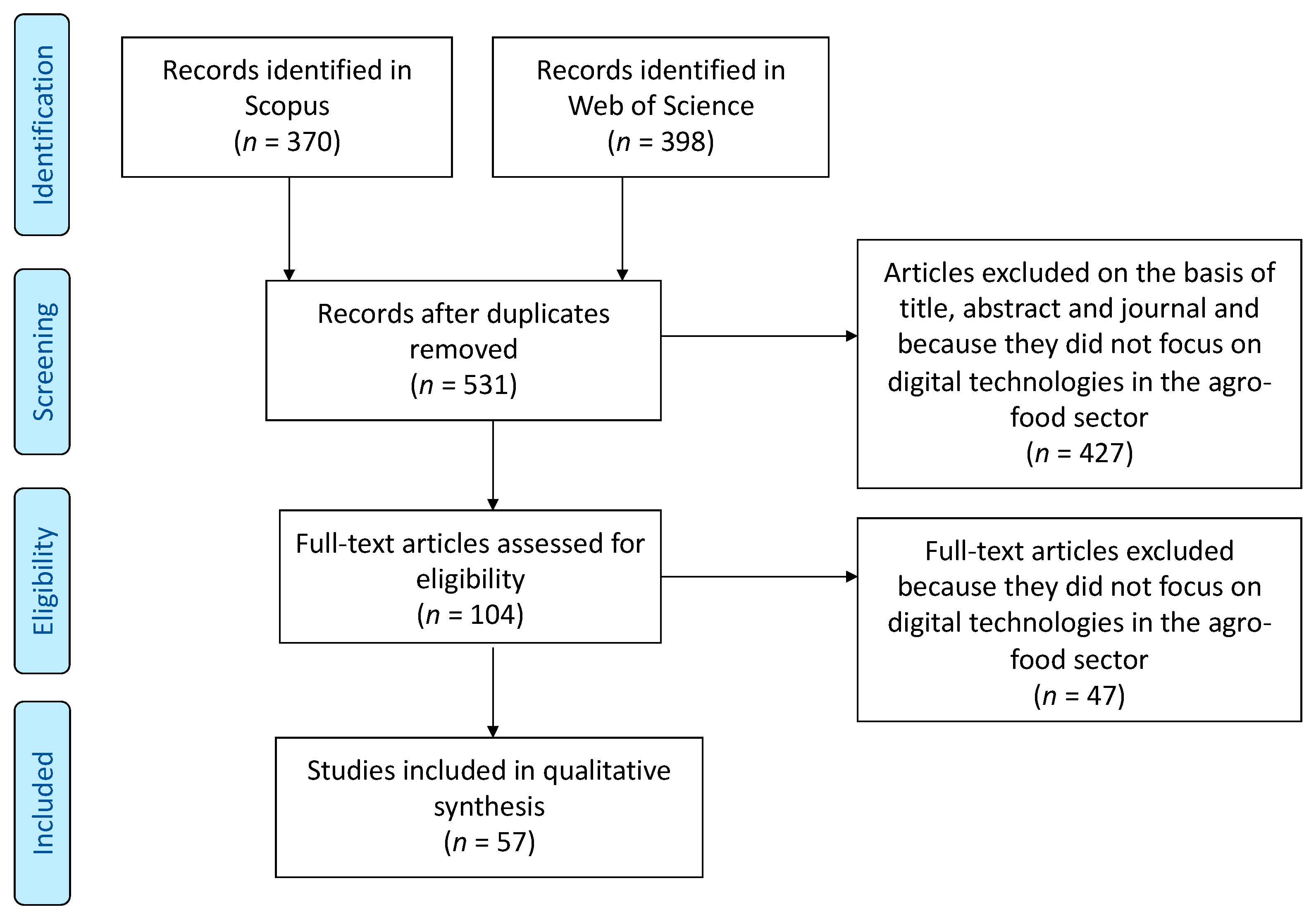
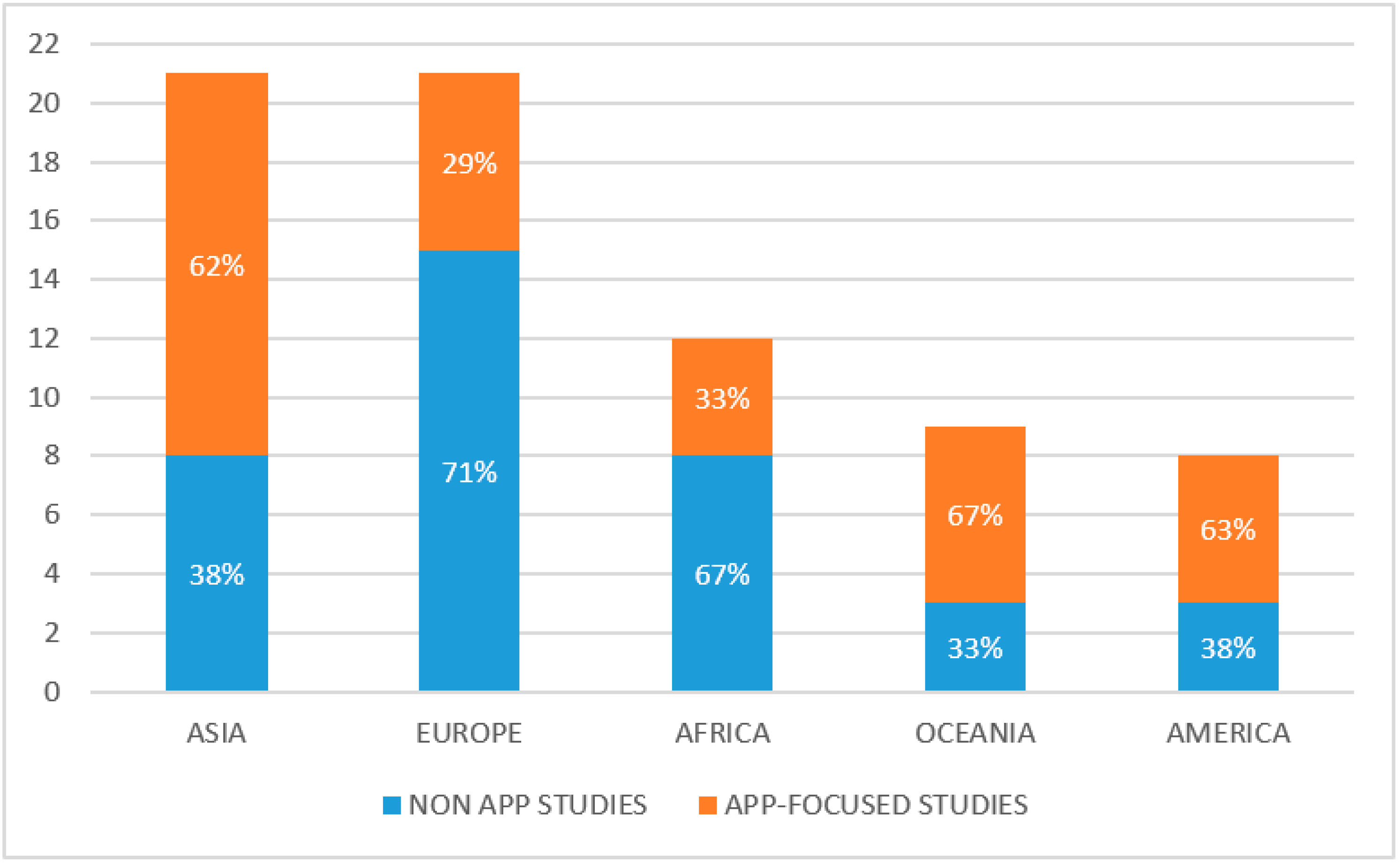
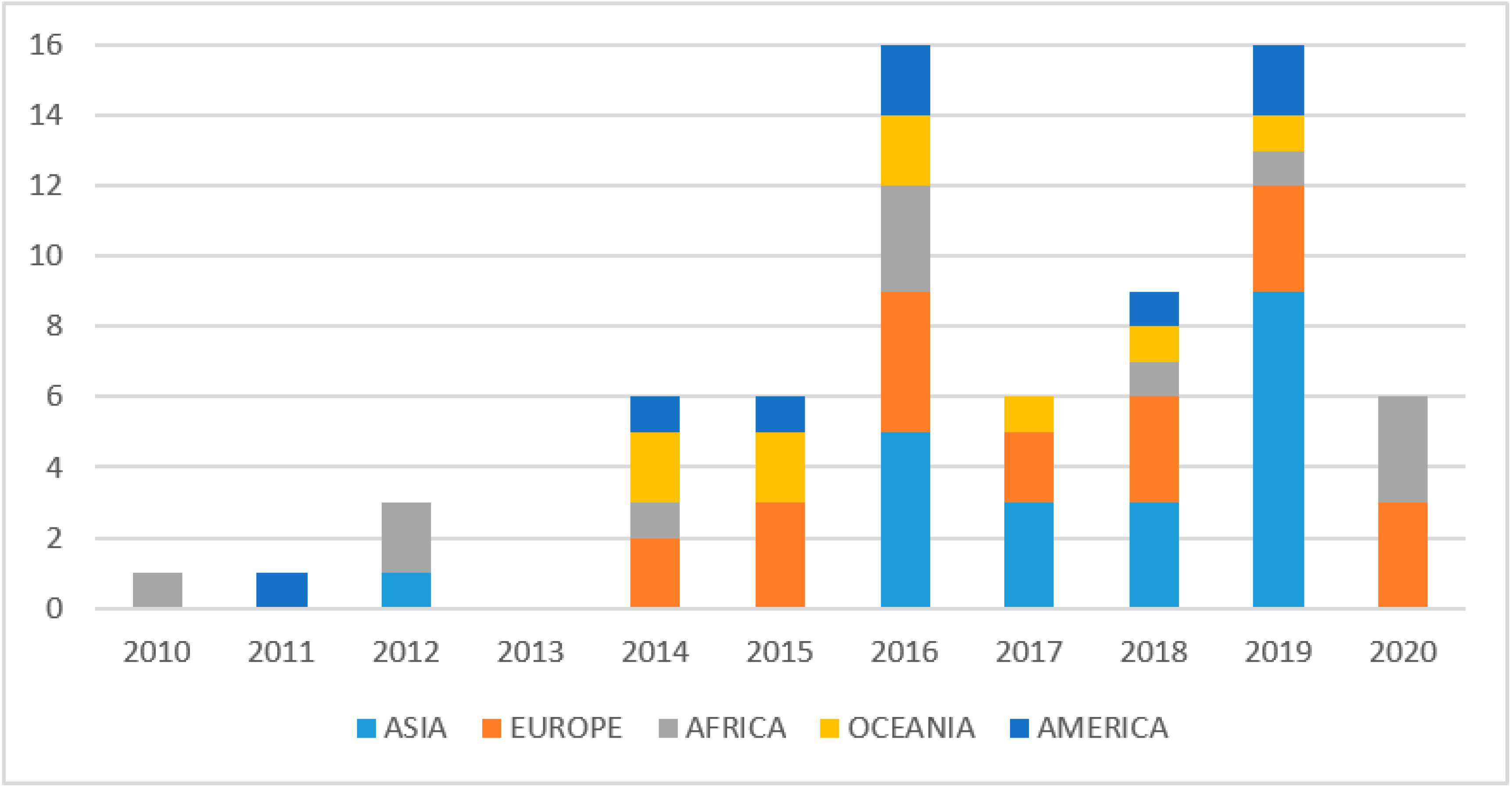
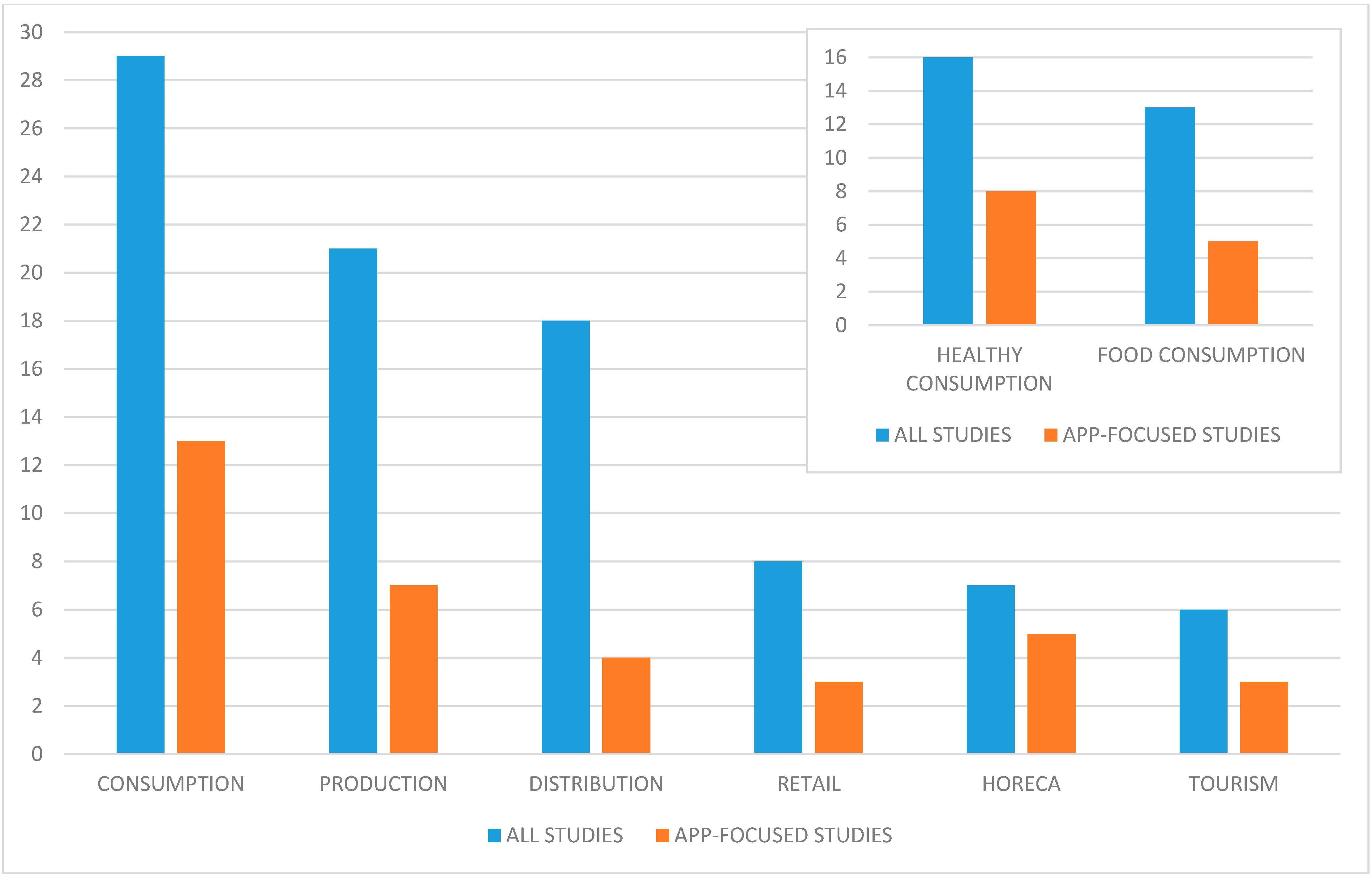
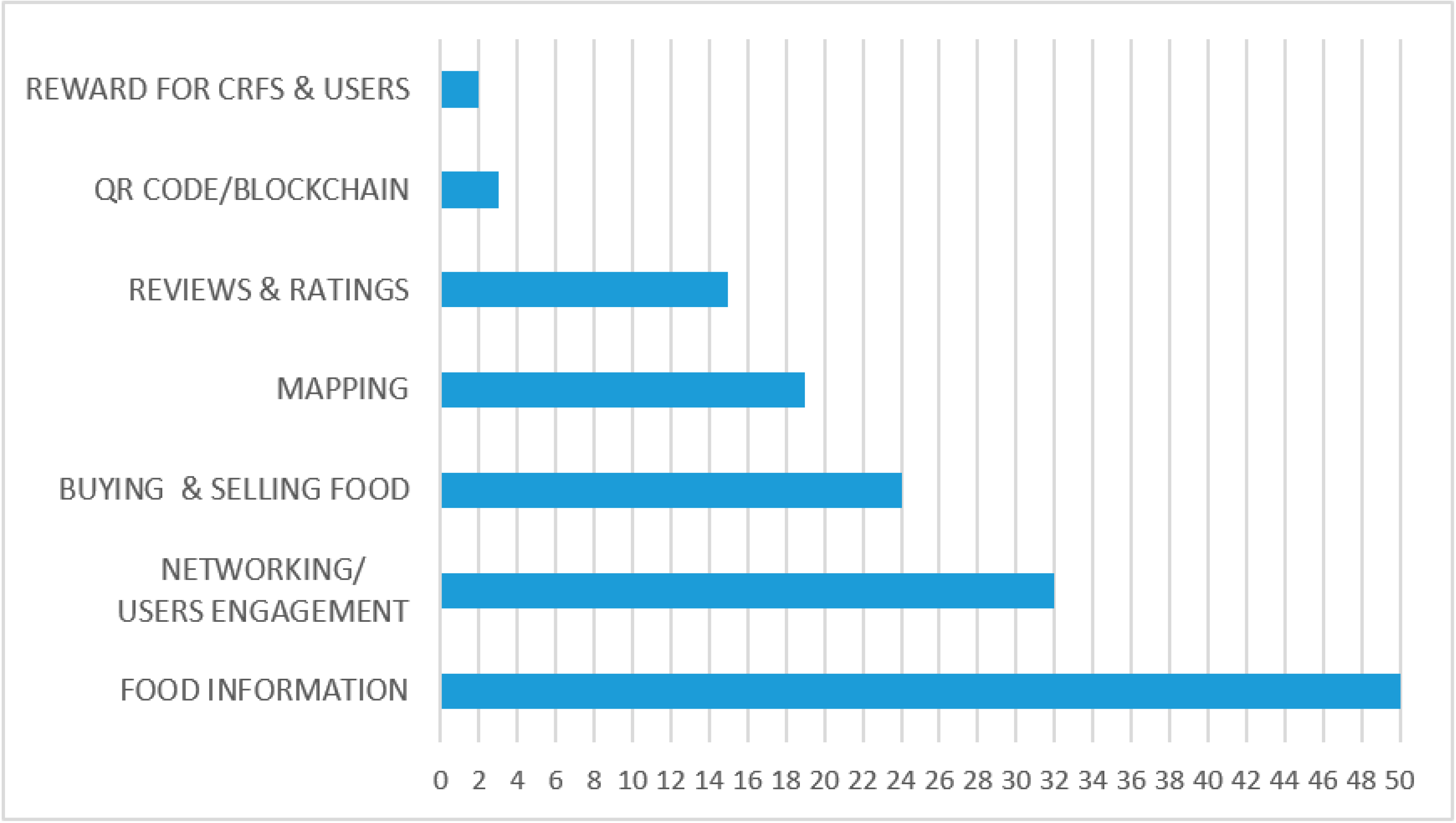
| Database | Search String | n of Studies Identified |
|---|---|---|
| Scopus | TITLE-ABS (mobile OR device OR digital OR “smartphone Application” OR App OR ict AND food OR agro-food OR agri-food AND urban OR local OR regional AND consumer OR consumption OR marketing OR commercialization OR distribution OR selling OR delivery OR trade AND NOT medic*) AND (LIMIT-TO (PUBYEAR, 2020) OR LIMIT-TO (PUBYEAR, 2019) OR LIMIT-TO (PUBYEAR, 2018) OR LIMIT-TO (PUBYEAR, 2017) OR LIMIT-TO (PUBYEAR, 2016) OR LIMIT-TO (PUBYEAR, 2015) OR LIMIT-TO (PUBYEAR, 2014) OR LIMIT-TO (PUBYEAR, 2013) OR LIMIT-TO (PUBYEAR, 2012) OR LIMIT-TO (PUBYEAR, 2011) OR LIMIT-TO (PUBYEAR, 2010)) | 370 |
| Web of Science | TOPIC: (mobile OR device OR digital OR “smartphone Application” OR App OR ict AND food OR agro-food OR agri-food) AND TOPIC: (urban OR local OR regional) AND TOPIC: (consumer OR consumption OR marketing OR commercialization OR distribution OR selling OR delivery OR trade) NOT TOPIC: (medic*) TIMESPAN: 2010–2020 | 398 |
| Continent | n of Studies | References | |
|---|---|---|---|
| 1 | Europe | 21 | [29,30,31,32,33,34,35,36,37,38,39,40,41,42,43,44,45,46,47,48,49] |
| 2 | Asia | 21 | [29,36,37,50,51,52,53,54,55,56,57,58,59,60,61,62,63,64,65,66,67] |
| 3 | Africa | 12 | [29,32,36,37,68,69,70,71,72,73,74,75] |
| 4 | Oceania | 9 | [29,36,37,76,77,78,79,80,81] |
| 5 | America | 8 | [29,36,37,77,82,83,84,85] |
| Type of Digital Technology | n of Studies | References | |
|---|---|---|---|
| 1 | Apps | 25 (44%) | [29,35,38,48,49,51,53,54,55,56,57,59,62,63,65,66,69,75,76,77,80,81,83,85] |
| 2 | Websites and platforms | 20 (35%) | [29,32,33,39,40,41,44,45,46,47,50,51,52,60,67,69,77,78,79,84] |
| 3 | Mobile phones and tablets | 9 (16%) | [30,34,58,61,68,70,72,74,84] |
| 4 | Social media | 6 (15%) | [42,64,71,73,77,84] |
| 5 | Print and broadcast media | 2 (4%) | [68,82] |
| 6 | Videogame | 1 (2%) | [43] |
| 7 | Modern kitchen appliance | 1 (2%) | [31] |
| Aim of Digital Technology | n of Studies | References | |
|---|---|---|---|
| 1 | Selling and buying agro-food products | 24 (42%) | [29,32,35,39,40,41,45,46,47,50,51,52,56,57,59,60,63,65,66,67,71,77,78,79] |
| 2 | Networking with consumers | 18 (32%) | [32,34,36,40,42,45,46,47,50,64,68,69,71,73,77,78,79,82] |
| 3 | Health advice | 17 (30%) | [30,37,38,43,49,55,58,61,62,72,74,76,80,81,83,84,85] |
| 4 | Food delivery | 16 (28%) | [32,39,40,41,46,51,52,56,59,63,65,66,67,77,78,79] |
| 5 | Food information | 13 (23%) | [32,34,35,36,38,42,55,62,64,68,76,77,82] |
| 6 | Networking among farmers | 9 (16%) | [29,45,46,47,50,51,60,69,71] |
| 7 | Restaurant mapping | 8 (14%) | [48,53,54,59,64,66,73,77] |
| 8 | Farm management | 8 (14%) | [29,50,51,56,60,69,70,75] |
| 9 | Travel information | 7 (12%) | [44,46,48,53,54,64,77] |
| 10 | Networking with the local community | 6 (11%) | [40,42,45,47,78,79] |
| 11 | Networking among all chain actors | 5 (9%) | [29,41,51,57,69] |
| 12 | Local farms information | 4 (7%) | [35,45,46,47] |
| 13 | Information on agricultural produce prices | 3 (5%) | [33,50,69] |
| 14 | Sustainability information | 2 (4%) | [31,35] |
| 15 | Seasonal food information | 1 (2%) | [85] |
| 16 | Local farm visit | 1 (2%) | [46] |
| 17 | Food waste management | 1 (2%) | [77] |
| Section of the Agro-Food Chain | n of Studies | References | |
|---|---|---|---|
| 1 | Consumption | 29 (51%) | [29,30,31,32,35,36,37,38,40,41,43,45,47,49,55,58,59,61,72,74,76,77,78,79,80,81,83,84,85] |
| 1a | Healthy Consumption | 16 | [30,37,38,43,49,55,58,61,72,74,76,80,81,83,84,85] |
| 1b | Food Consumption | 13 | [29,31,32,35,36,40,41,45,47,59,77,78,79] |
| 2 | Production | 21 (37%) | [29,31,32,33,40,41,42,45,46,47,50,51,56,57,60,69,70,71,75,77,82] |
| 2 | Distribution | 18 (32%) | [29,31,32,39,40,41,46,47,50,51,56,60,68,71,77,78,79,82] |
| 3 | Retail | 8 (14%) | [29,31,33,39,52,57,65,67] |
| 4 | HORECA | 7 (12%) | [59,62,63,64,66,72,77] |
| 5 | Tourism | 6 (10%) | [42,44,46,48,53,54] |
Publisher’s Note: MDPI stays neutral with regard to jurisdictional claims in published maps and institutional affiliations. |
© 2021 by the authors. Licensee MDPI, Basel, Switzerland. This article is an open access article distributed under the terms and conditions of the Creative Commons Attribution (CC BY) license (http://creativecommons.org/licenses/by/4.0/).
Share and Cite
Samoggia, A.; Monticone, F.; Bertazzoli, A. Innovative Digital Technologies for Purchasing and Consumption in Urban and Regional Agro-Food Systems: A Systematic Review. Foods 2021, 10, 208. https://doi.org/10.3390/foods10020208
Samoggia A, Monticone F, Bertazzoli A. Innovative Digital Technologies for Purchasing and Consumption in Urban and Regional Agro-Food Systems: A Systematic Review. Foods. 2021; 10(2):208. https://doi.org/10.3390/foods10020208
Chicago/Turabian StyleSamoggia, Antonella, Francesca Monticone, and Aldo Bertazzoli. 2021. "Innovative Digital Technologies for Purchasing and Consumption in Urban and Regional Agro-Food Systems: A Systematic Review" Foods 10, no. 2: 208. https://doi.org/10.3390/foods10020208
APA StyleSamoggia, A., Monticone, F., & Bertazzoli, A. (2021). Innovative Digital Technologies for Purchasing and Consumption in Urban and Regional Agro-Food Systems: A Systematic Review. Foods, 10(2), 208. https://doi.org/10.3390/foods10020208





